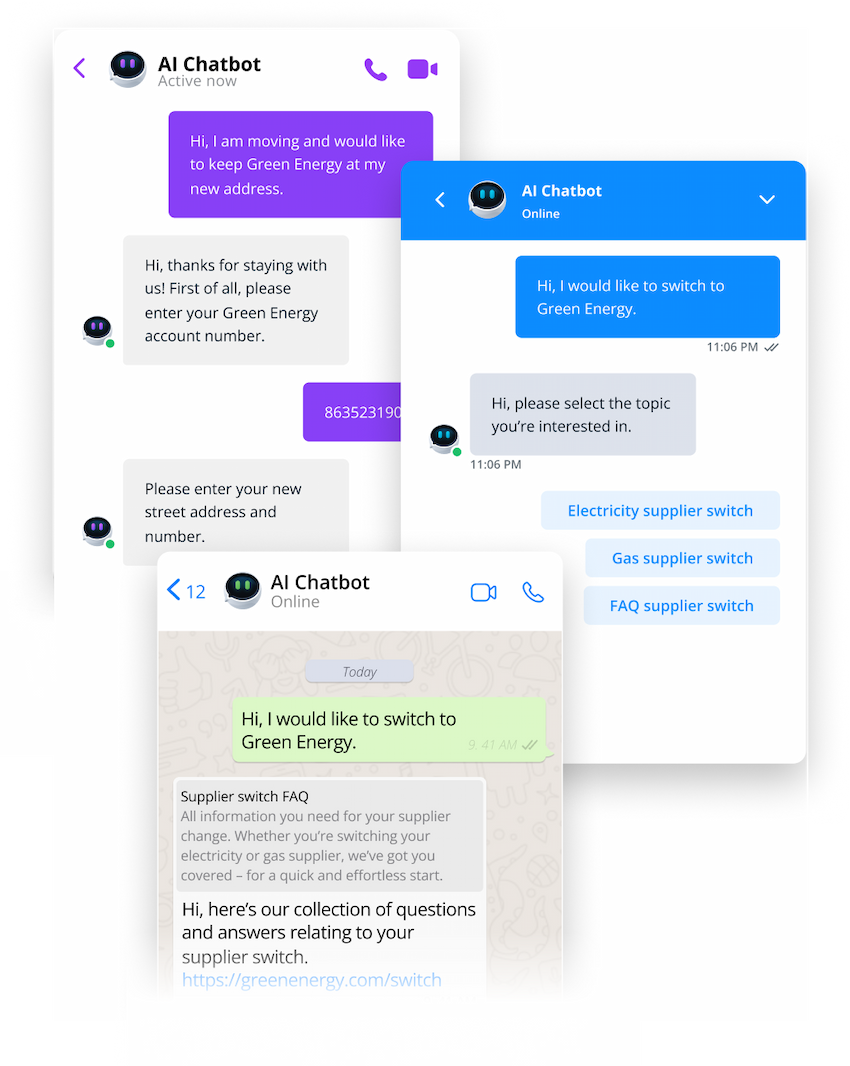
5 Ways to Use a Chatbot for University Students
The summer before I started college I called the admissions office so often that I memorized the number.
There are so many details to consider when applying for universities, some that aren’t so obvious to students. For example, when my niece told me she was applying to 15 schools I said, “Wow, that’s a lot of application fees” to which she replied, “You have to pay to apply?!”
Application requirements, tuition due dates, housing, orientation — these are all topics a chatbot can easily cover. Of course, this information already exists on your website, but it’s kept behind multilayer navigation. A chatbot can help a student find the information relevant to them, whether they’re a prospective or returning student.
But chatbot benefits don’t end at application and enrollment — this is a chance to get creative and impress your students with a modern, interactive digital assistant. Check out these five use cases and benefits for inspiration.
5 use cases and benefits of a university chatbot
- Answer questions students ask most
- Offer omnichannel asynchronous support
- Provide admission/enrollment assistance
- Proactively engage with site visitors
- Give your university a voice
1
Answer questions students ask most
“How do I log in to the student portal?”
“When will the new course catalog be available?”
“When is tuition due?”
These types of questions may be all too familiar to your staff, and they’re ones a chatbot can answer.
Use your chatbot as a direct support line for frequently asked questions. It can proactively greet your site visitors by triggering a welcome message and showing a menu of possible conversation paths.

By connecting your chatbot to an existing knowledge base and/or writing a comprehensive script flow, you can answer questions students ask most — without your staff ever having to pick up the chat.
However, it’s important to have an easy escalation option within the chat. We recommend connecting your chatbot to your live chat software for easy management. A staff member can then pick up the chat where the bot left off, and the conversation (and the contact’s details) are saved in the software for future reference.
Benefits you can expect:
- Stay focused on important inquiries. Reduce the contact burden on your staff and faculty: use a chatbot to answer common questions and forward the difficult ones to the appropriate personnel.
- Increase response and resolution rate. Proactively approach your site visitors and offer sitewide help to reduce your response rate to just seconds. And by equipping your chatbot with updated university knowledge, you will experience fewer tickets/chat forwards and a faster resolution rate.
- Offer low barrier contact. Younger generations prefer the familiar nature of modern messaging apps. Support your students by deploying a WhatsApp chatbot, for example, so students can ask questions at their convenience.
2
Offer omnichannel asynchronous support

For students, their university becomes their family and home away from home, so having direct contact is important. Because Gen Z is familiar and comfortable with asynchronous communication, you can use your chatbot as a pocket assistant for your whole campus.
Chatbots, like Userlike’s AI chatbot, can talk to students, faculty and staff via popular messaging channels such as WhatsApp, Facebook Messenger, SMS and more. All messages land in the Message Center, where staff can check the quality of its answers and any forwarded inquiries.
Benefits you can expect:
- Easily accessible for everyone. Provide assistance on your website and familiar apps for on-the-go support.
- Direct connection to students. Students can rely on your chatbot for help without having to be at a computer. You can also reach your students no matter where they are.
- Cuts down on calls. Your offices aren’t a call center. Chatbot help is endless and on multiple channels, which may reduce the amount of calls your staff receives.

Want to talk to a human about chatbots?
We'd be happy to answer any questions you have about using chatbots in your business and how to get started.
Book an appointment
3
Provide admission/enrollment assistance
A chatbot can provide on-screen guidance during the admission process. This optional support may be useful to students who have a more complicated application process — like international students, for example.
Chatbots can also send any important digital documents students failed to download or lost, such as a copy of their online application or student aid forms.

Once they apply, students are hungry for feedback. They can ask a chatbot for an update on their application, such as if it’s in review, if there are documents missing or if they’ve been accepted.
Benefits you can expect:
- Relieve student stress. Depending on the student, applying may be a complex process. A chatbot can explain what type of documents are needed and give instant status updates.
- Reduces paper waste/lost documents. Environmental concerns are important to Gen Z, and more and more universities are attempting to go digital to cut down paper waste. Our AI chatbot, for example, supports in-chat media, so you can easily send important documents within the chat.
- Build instant student profiles. Grow your student and applicant database by automatically collecting and storing information sent in the chat. This makes it easier to familiarize yourself with a student’s specific situation and keep a record of your messages.
4
Proactively engage with site visitors
A common doubt about using proactive greetings is that it may disturb the visitor’s browsing experience. For universities, however, a chatbot message may encourage students and parents to ask questions without inhibitions.
You can set the chatbot to trigger 5-10 seconds after they’ve landed on a page with a targeted greeting.

We recommend a combination of proactive and reactive chat across your website. Use proactive messages on pages with a topic students often ask about. The trigger message should also be specific to that page. For example, if you embed a chatbot on your “majors and minors” page, your chatbot could say, “Hi there? Do you need help choosing a major? Take our quiz to find out which one is right for you.”
A proactive chatbot is also handy for showing off your course offerings, student life and answering application questions.
Benefits you can expect:
- Make students feel seen. Students research dozens of schools before applying, but likely aren’t approached by a chatbot during every site visit. Stand out by inviting your visitor to a conversation when they land on your website.
- Eliminate doubt. A warm, informative chatbot conversation may be the final “push” a student needs to confidently apply — especially if it offers to assist with the process and keep the student updated.
- Show off your university. Decide what impression you want students to have of your school, and share that through a chatbot. Show off unique aspects, like a study abroad program or environmental learning center, that students otherwise wouldn’t stumble upon during their research.
5
Give your university a voice
Does your university have a mascot? Use it as your chatbot! Talking to a bear or a maple leaf (yes, we were called the “fighting maple leafs” at my college) is a lot more engaging and memorable than a standard bot.
Plus it’s a chance to share your university’s personality and be creative. A chatbot with a well-written script and persona can make a good impression on incoming students — it shows you are growing with technology and putting effort into your student communication.
Benefits you can expect:
- Influence visitors’ perception of your university. How well your chatbot behaves, speaks and shares information will reflect on your university. You control its speech, image and general usefulness, which helps earn trust and respect.
- Make a unique impression. Chatbots are still relatively unexpected on university websites. You can reach more students in a fun, interactive way that they will perceive as modern and innovative.
Three university chatbot providers
We’ve already covered our top chatbot provider picks, but narrowed down our list even further with universities in mind. Take a look at these three options ranging in price and functionality to see which one fits your needs.
- Landbot: low-code option
- Cognigy: contextual option
- Userlike: all-in-one option
Landbot provides a no-code interface for building complex chatbot flows. It’s a rule-based solution that works on a decision tree “if/then” logic, which means it follows its script and doesn’t generate its own text like a contextual chatbot.

It’s an ideal solution for creating quick conversations, though it’s limited in its fallback capabilities because it isn’t connected to live chat software.
Chatbot type: Button-based decision tree
Compatible apps: WhatsApp, Facebook Messenger
Price: Ranges from free to $100 a month, plus larger customized plans
Cognigy is a conversational AI platform for creating an advanced chatbot. You can design humanlike conversations using its low-code conversation editor.

It uses deep learning algorithms to learn from and improve its conversations. This is the type of chatbot you need if you’re looking for a more advanced setup with natural language processing.
It’s also omnichannel-capable, which means you can connect it to your live chat provider’s API, like Userlike’s HTTP framework, to have a fallback solution.
Chatbot type: Contextual
Compatible apps: Integrates with CRMs, ERPs, RPAs and more
Price: Must inquire for pricing
Userlike’s AI Automation Hub is a central knowledge base that’s connected to our customer messaging software. You can create your own AI chatbot that greets and chats with students just like a member of your staff. It pulls information from your knowledge base to give consistent, accurate answers.

The AI chatbot picks up conversations where customers left off — a perk not every chatbot platform provides. Most chatbots “reset” once you leave the website, but customers can see their previous conversation with the AI chatbot before deciding to continue it or start a new one.
You can also display button options and carousels within the chat for attractive, easy navigation. If the chatbot can’t answer a question, it can easily forward the chat to an available agent.
Chatbot type: Contextual
Compatible apps: WhatsApp, Facebook Messenger, Telegram, Threema, SMS
Price: Available from Corporate plan on
University chatbot: Avoid this mistake
Maybe you’re still reading about the pros and cons of having a university chatbot. It can be a huge time and money investment, so we understand the need to research with a keen eye.
However, researching and choosing a chatbot without already having live chat is like canoeing before you learn to swim. It’s possible, but not recommended.
Live chat will familiarize your team with the nature of supporting visitors directly on your website — plus make it easy to connect and deploy a sophisticated chatbot. This allows for simple handovers from bot to human whenever needed.

At Userlike, our AI Automation Hub will turn your university website into a valuable, self-service resource. In addition to our AI chatbot, we offer a Smart FAQ and Contact Form Suggestions, which pull answers from its knowledge base full of your university data.
The Smart FAQ is a responsive self-service portal that helps visitors resolve their issues quickly. You can pin popular topics to the top and ensure that students receive consistent answers with every search.

Contact Form Suggestions attempts to answer the person’s question before they write to your staff. This reduces tickets and redundant inquiries, freeing up your staff’s time.
Both features use auto-completion to answer a question as it’s being typed, saving time and effort.
And the best part - the AI Automation Hub doesn’t require a developer or IT experience to set it up.
Sign up for our free 14-day trial to get an impression of Userlike’s AI Automation Hub. If you like what you see, we’d be more than happy to set up a call to discuss our AI features to see if it’s a good fit for your university.

